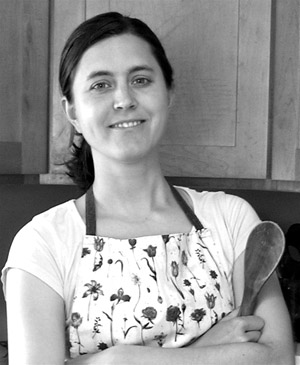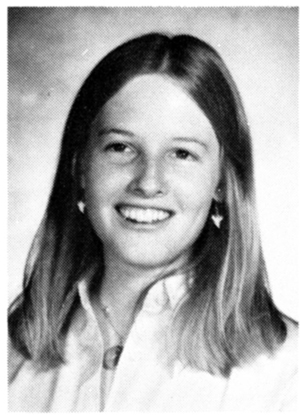FINESSING FOOD ALLERGIES: AMANDA SNYDER ’00

By Nancy Fontaine
It’s the end of a busy day. You rush into the kitchen with a bag of groceries after having spent many long and frustrating minutes examining food labels because the kids have allergies. They start fighting in the next room because they’re hungry and tired, as are you. The kitchen is a mess, and you wish the food would just put away and cook itself.
Enter Amanda (Mandy) Snyder ’00 of Sebastopol, Calif. Snyder is a personal chef specializing in food sensitivities and special diets. “I prepare meals in my clients’ homes to be heated at their convenience,” she says. “I do the shopping and clean and stock the kitchen with fresh, organic food.”
Snyder’s service is not only convenient but also timely, with rates of food allergy on the rise. Although allergies appear to have a genetic component, there is no consensus on the cause of their rapid upsurge. Environmental factors, such as pollution and pesticides, may play a role, and diet has been implicated by some research. Studies done in Europe have correlated fast food eaten during pregnancy and early childhood with increased allergies, and following a Mediterranean diet (high in olive oil and fish and low in red meat) with a decrease.
Being allergic or otherwise reactive to foods means going to great lengths to avoid troublesome ingredients. “If somebody is sensitive to sugar, there are so many products that they can’t eat,” Snyder explains. “It is in many items we wouldn’t even consider: flavored potato chips, salad dressings, ketchup, mayonnaise, all types of breads and crackers. I tried to buy a black olive spread and found many brands with sugar.”
Living with food restrictions can mean that whole categories of pleasurable textures are not readily available. “People who can’t have gluten products will miss the chewiness that breads made with wheat offer,” says Snyder. Manufacturers know this and compensate with other ingredients. “Many gluten-free products have xanthan gum, gelatin or guar gum to add some chew.”
Cheese is a food that is often sorely missed. It has a particular consistency—“that gooey, melty and stretchy experience” that people avoiding dairy miss, says Snyder .“There are some great new dairy-free cheeses on the market, like the Daiya brand,” she recommends. It’s also possible to skip the cheese and still cook classic dishes. “You can make a good dairy-free lasagna using tofu and cashews blended as cheese substitute— together they lend the spongy and grainy texture usually found in ricotta cheese. Also, to mimic the texture of parmesan cheese, I will toast some cashews and grind them with salt and nutritional yeast, and sprinkle this gritty and salty garnish on top.”
Low-fat cooking also poses texture issues. “When you need to make low-fat dishes use the oil or butter so that it is on the surface of the food,” advises Snyder. “The mouth-feel, that slippery rich taste, is what we love most about eating a fatty food. So if you make a pasta dish or a soup that is low-fat and plan to use a little olive oil or butter, drizzle it on right before serving.”
Eggs are another challenging food to avoid. “Eggs contribute many properties to baked goods, such as binding (so that your cookies don’t crumble). One of my favorites for adding binding and moisture is golden flaxseed meal,” Snyder offers. “When mixed with a little water it forms a gel very similar in consistency to an egg, and provides structure for cookies and muffins as well as adds extra nutrition. Some folks like to use chia seeds this way as well.”
To create rise in muffins and cakes, Snyder uses “baking soda and a little acid like vinegar or lemon juice—remember that science experiment in fifth grade?—when mixed together they create air bubbles helping your blueberry muffins to create those round muffin tops.”
One restriction may be hard enough to work around, but when there are many? “One of my most challenging clients is someone who wants low-fat foods and can’t eat dairy or cane sugar but loves desserts,” Snyder says. “We’ve worked together to come up with recipes that use natural sweeteners like maple syrup, fruit, and fruit juices. One successful treat I made for her is an apple coffee cake made with soy yogurt to keep it moist and a bit of Earth Balance butter substitute mixed with maple sugar to give it that traditional buttery sweet taste on top.”
Another demanding regimen Snyder has tackled is the Paleo Diet, which strives to mimic the food eaten by our hunter-gatherer ancestors. “Basically it means no grains, beans, or dairy. I found that using a mixture of pine and macadamia nuts blended into a soup gave it a nice creamy texture, and I used this to my advantage to create bisques like butternut squash bisque and roasted tomato bisque.”
Snyder knows about special diets through firsthand experience. A dance and women’s studies major as an undergrad, she started a dance troupe in San Francisco and was living her dream, until she had a turn in her health. “I started getting sick and didn’t know why,” she says. “I felt like I had a cold or virus and couldn’t get through the day without napping in the afternoon. I went to the walk-in clinics at the local hospitals, and they told me to go home and rest!” When they pulled up the carpet in her room in the house she shared, they found black mold.
While doctors don’t consider black mold a cause of disease except in rare instances, many people report difficulties such as Snyder’s when exposed to it. The lack of support from the medical community makes dealing with the issue all the more challenging. Snyder had to figure out for herself what was helpful and what wasn’t. “I noticed that I felt worse after eating some foods and began to avoid them. It was trial and error.”
Snyder’s advice for those faced with food issues is first to be very clear about the specifics. What, exactly, are they allergic or sensitive to? She says, “Some clients may have an allergy to milk protein, so they can’t have cheese or yogurt, but they can have ghee, which is the fat from dairy cows.”
It’s also important to be clear about the extent of the food allergy. Is it life threatening or is it going to cause mild indigestion? “Many people have sensitivities to gluten, but only some have a true allergy where even very tiny quantities can make them very ill. Knowing this will affect how you prepare the food.”
After figuring out what someone can’t eat, it’s time to find favorite foods that they still can eat. Snyder says, “Base your meals around these items and get creative. For example, if someone loves sweet potatoes, but can no longer drench them in butter, try them with a spoonful of coconut milk or prepare them in different ways: roasted, or pureed into a soup.”
Snyder finds great satisfaction in helping others with health issues like hers. “When I got sick, it was isolating. I couldn’t do things like go out to restaurants. People often didn’t understand,” she says. “It’s hard enough to be sick without that.” She takes care of herself by eating well, meditating, and exercising, and she is thriving. “My business is going really well,” she reports happily, “and I am still loving it.”


